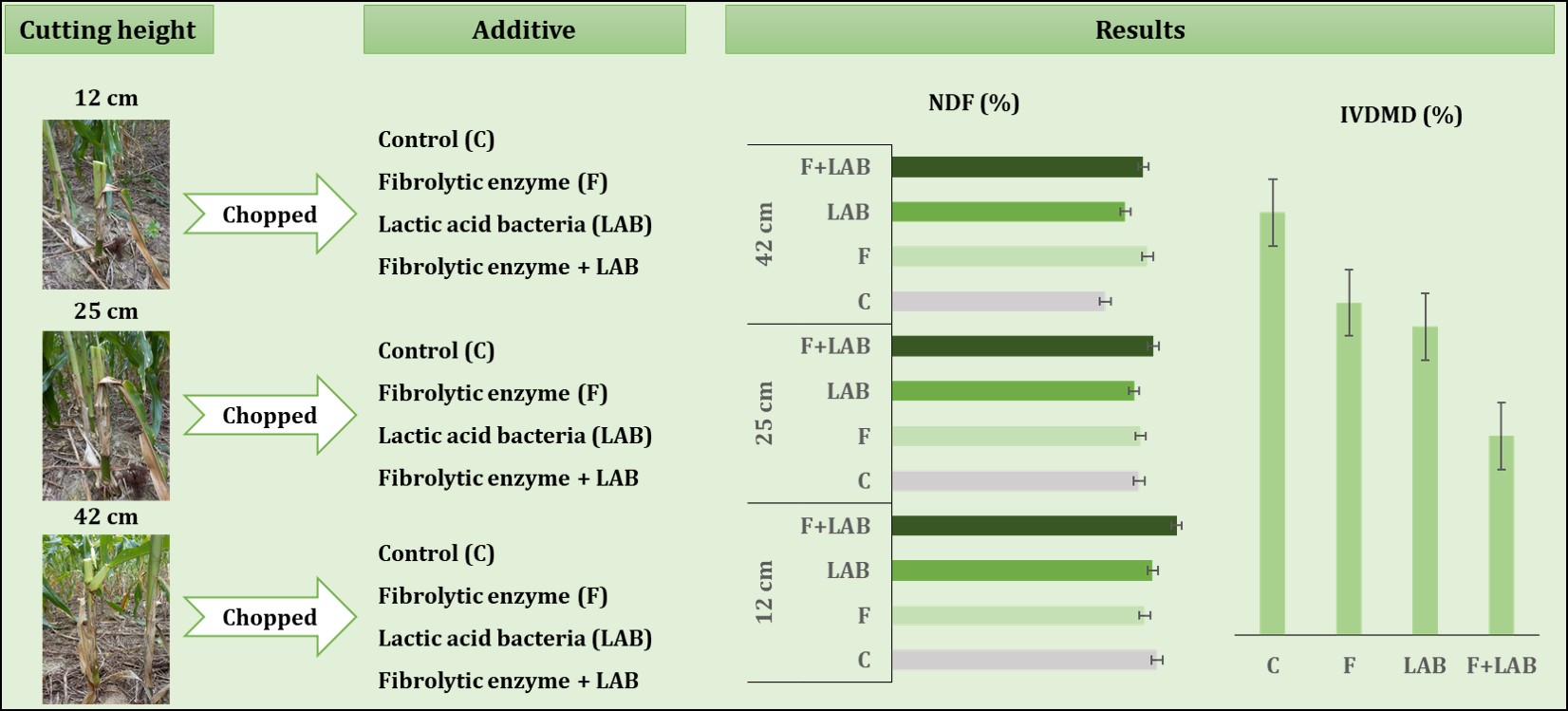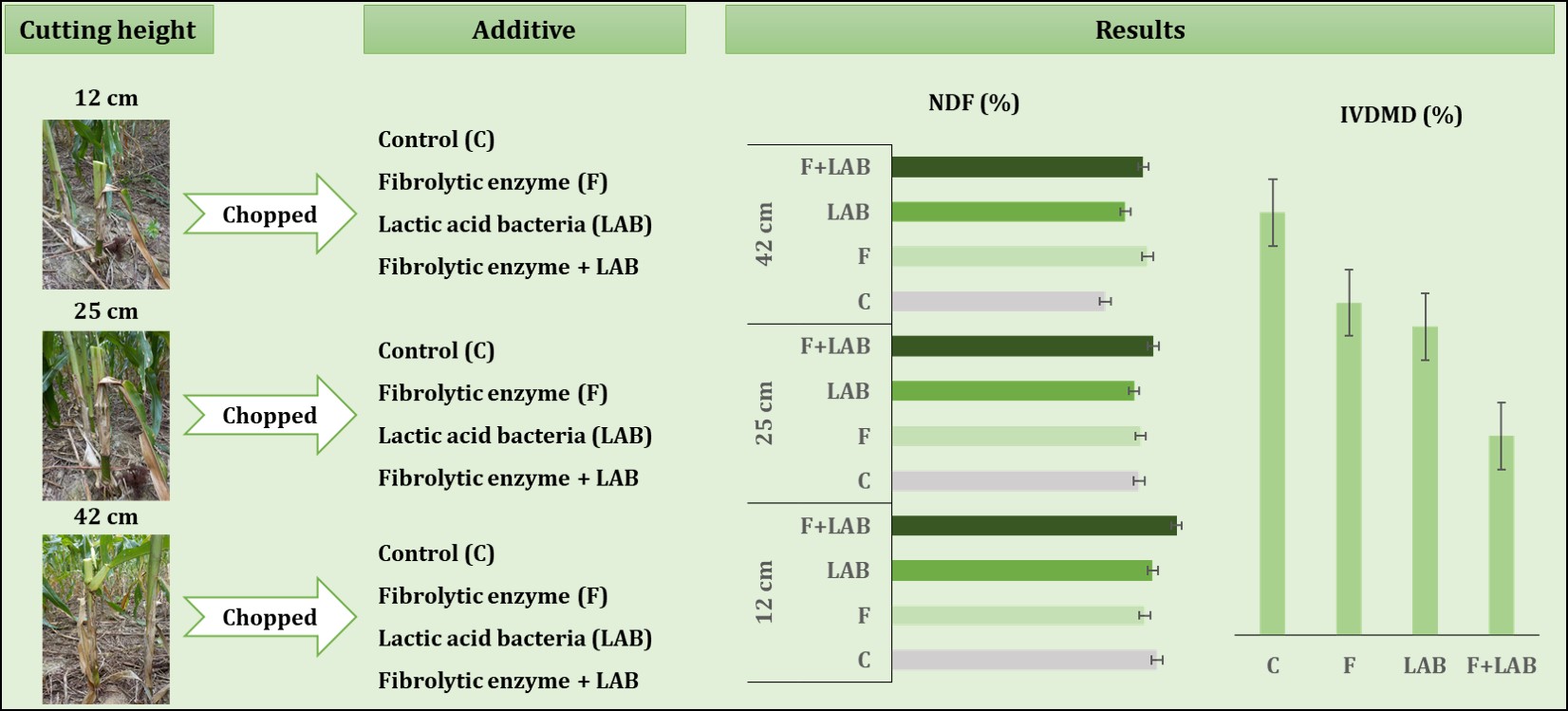Effect of cutting height, a bacterial inoculant and a fibrolytic enzyme on corn (Zea mays L.) silage quality
DOI:
https://doi.org/10.48162/rev.39.115Palabras clave:
aditivos, almidón, biomasa, carbohidratos solubles, DFDN, digestibilidad, fibraResumen
 This study aimed to evaluate cutting height (CH) effects on ensiled corn without additives (C), with a lactic acid bacteria inoculant (L), a fibrolytic enzyme (F), or a mixture of both (FL), considering chemical composition and both in vitro digestibility dry matter (IVDMD) and in vitro neutral detergent fiber (IVNDFD). Corn was harvested at three different cutting heights (12, 25 or 42 cm above the soil) and ensiled with or without additives (AD). Data was analyzed according to a factorial design, with a 3 x 4 arrangement of treatments and three repeats. Dry matter content was highest in C12 and lowest in F12 (P<0.05) silages. As cutting height was higher, cell wall content was lower (P<0.05). Even considering it increased after the use of additives (P<0.05), the highest values occurred with FL silages. Crude protein was equal (P˃0.05) between CH and increased (P<0.05) with AD. The highest IVDMD was observed for 42 cm CH, while IVDMD and IVNDFD were higher in C and F, but lower with FL. None of the inoculation treatments, alone or combined improved corn silage quality. In fact, FL combination decreased such quality.
This study aimed to evaluate cutting height (CH) effects on ensiled corn without additives (C), with a lactic acid bacteria inoculant (L), a fibrolytic enzyme (F), or a mixture of both (FL), considering chemical composition and both in vitro digestibility dry matter (IVDMD) and in vitro neutral detergent fiber (IVNDFD). Corn was harvested at three different cutting heights (12, 25 or 42 cm above the soil) and ensiled with or without additives (AD). Data was analyzed according to a factorial design, with a 3 x 4 arrangement of treatments and three repeats. Dry matter content was highest in C12 and lowest in F12 (P<0.05) silages. As cutting height was higher, cell wall content was lower (P<0.05). Even considering it increased after the use of additives (P<0.05), the highest values occurred with FL silages. Crude protein was equal (P˃0.05) between CH and increased (P<0.05) with AD. The highest IVDMD was observed for 42 cm CH, while IVDMD and IVNDFD were higher in C and F, but lower with FL. None of the inoculation treatments, alone or combined improved corn silage quality. In fact, FL combination decreased such quality.
Highlights:
- The efficacy of lactic acid bacteria (LAB) and exogenous fibrolytic enzyme (EFE) is a funtion of the amount of cell walls and sugars present in the maize plant at harvest.
- Adding LAB and EFE to maize forage harvested at different cutting heights did not improve silage quality, in fact, the combination of both additives decreased silage quality.
- Further studies are needed to prove the efficacy of EFE and its combination with LAB on maize silage quality.
Descargas

Descargas
Publicado
Cómo citar
Número
Sección
Licencia
Derechos de autor 2018 Revista de la Facultad de Ciencias Agrarias UNCuyo

Esta obra está bajo una licencia internacional Creative Commons Reconocimiento-NoComercial-CompartirIgual 3.0.
Aquellos autores/as que tengan publicaciones con esta revista, aceptan las Políticas Editoriales.










.jpg)




